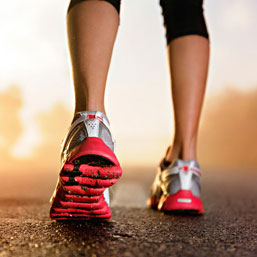- Like
- SHARE
- Digg
- Del
- Tumblr
- VKontakte
- Flattr
- Buffer
- Love This
- Save
- Odnoklassniki
- Meneame
- Blogger
- Amazon
- Yahoo Mail
- Gmail
- AOL
- Newsvine
- HackerNews
- Evernote
- MySpace
- Mail.ru
- Viadeo
- Line
- Comments
- Yummly
- SMS
- Viber
- Telegram
- JOIN
- Skype
- Facebook Messenger
- Kakao
- LiveJournal
- Yammer
- Edgar
- Fintel
- Mix
- Instapaper
- Copy Link
 Correcting Overpronation: What You Need to Know
Correcting Overpronation: What You Need to Know
You know that walking is a great form of exercise for people of all ages and skill levels. But, have you ever stopped to think about the way you walk and how it could be affecting your performance inside and outside of the gym?
Taking the time to understand the way you walk and identify incorrect movement patterns can have a significant impact on the way you move and perform basic functions.
 Of the incorrect movement patterns that people practice, overpronation is one of the most common. Overpronation refers to the feet rolling inward more than normal as you walk or run; it hinders the foot’s ability to properly absorb shock when you’re walking or running.
Of the incorrect movement patterns that people practice, overpronation is one of the most common. Overpronation refers to the feet rolling inward more than normal as you walk or run; it hinders the foot’s ability to properly absorb shock when you’re walking or running.
It also often leads to pain in the ankles, knees, hips, and lower back and can cause problems in the feet since it adds pressure to the inner toes. People who overpronate often struggle with calluses, bunions, and inflammatory conditions like plantar fasciitis.
Top Three Tips to Correct Overpronation
If you overpronate and are dealing with any of the issues we’ve covered above, there are some simple things you can do to start correcting your movement patterns for good. Start with the three tips listed below:
#1. Identify the Problem and Adjust Your Form
By breaking down your form during common activities like walking, running, and even standing, you’ll be able to identify and address your weaknesses.
When you’re standing, pay attention to where your weight goes. Is it evenly distributed over the center of your foot? Or, are your ankles caving in, with more weight being placed on the inner arches?
Pay attention to the way you walk and run, too.
Try to avoid striking with your heel and keeping the toes pointing down — both patterns put extra stress on your feet and contribute to overpronation. Instead, focus on shortening your stride and landing softly with your midfoot. This can help you avoid overpronation and the injuries that often accompany it.
#2. Stretch and Strengthen
Overpronation often causes stiffness in the legs and lower back. When these muscles are always tight, it’s harder to change poor recruitment patterns, and you’ll be more likely to continue moving in the way that caused the pain.
Focus on stretching your legs and feet regularly to improve range of motion and eliminate tightness that contributes to overpronation.
Stretch the calves, hamstrings, and iliotibial bands (side of the thigh) regularly. You can also foam roll these areas to loosen them up further.
In addition to stretching your muscles, you should also focus on strengthening the ankles and calves. This will help change the way you recruit your muscles and you stand, run, and walk.
Calf raises are one of the best exercises you can do to correct overpronation. Do them slowly while focusing on keeping your weight in the middle of your foot and avoiding letting the ankles roll in or out.
#3. Invest in Some New Equipment
Wearing shoes that promote motion stability are another good option for people who regularly overpronate.
Motion stability shoes are thicker and firmer than traditional athletic shoes. They help support the ankles to stop them from rolling inward as you walk and run.
If you’re not ready to invest in a brand new pair of shoes, you can also wear insoles that are specifically designed to prevent overpronation.
Ankle braces can also help support the ankles and prevent them from rolling inward. Knee braces that prevent twisting of the knee joints when exercising are also beneficial for people for whom overpronation also causes knee and/or iliotibial band pain.
Orthotics, new shoes, and braces can be good tools, especially if you’ve got a big race or event coming up and need some support right away.
But, they work best when combined with strengthening and stretching techniques, too. Otherwise, you won’t be correcting the actual problem and will just be putting a band-aid on it.
The Bottom Line
If you’re someone who overpronates, these tips can help correct poor recruitment patterns and improve your performance in the gym or on the field.
Even if you’re not an athlete or avid exerciser, correcting overpronation will help you avoid joint pain and can help you perform everyday activities with more ease.

